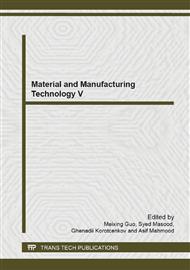[1]
V. Ayala, V. Magnotta, A. O'Czerny, J.R. Zierdt and R. Zanchin, Evaluation of oxidized white liquor as an alkali source, Oxygen Delignification Symposium, pp.153-161, (1990).
Google Scholar
[2]
T. Nykanen, J.R. Phillips, and J. Richardsen, White liquor oxidation for bleach plant use, Glens Falls, New York, U.S. Patent Pat. WO 94/01616, (1994).
Google Scholar
[3]
M. M. Hurst, The use of oxidized white liquor as a caustic replacement in O, Eo, Eop and E2 bleaching stage of kraft hardwood and softwood pulp, Tappi journal, vol. 83, (2000).
Google Scholar
[4]
N. Jemma, M. Duhamel, B. Van Lierop, M. Paleologou, R. Thompson, R. Berry, C. Brown and M. Sheedy, Removal of sodium thiosulphate from partially oxidized white liquor and use of the thiosulphate-lean solution in bleaching, Pulp and Paper Canada, vol. 104, pp.293-303, (2003).
Google Scholar
[5]
B.G. Hultman and S.E.O. Noreus, Method for production oxidized white liquor, U.S. Patent U.S. pat. 4, 053, 352, (1977).
Google Scholar
[6]
J.L. Colodette, A.S. Campos and J.L. Gomide, Attempts to use white liquor as the source of alkali in the oxygen delignification of Eucalypt kraft pulp, Tappi Oxygen Delignification Symposium Notes, p.145, (1990).
DOI: 10.32964/tj15.9.609
Google Scholar
[7]
J.P.T. Fiskari, Oxidized white liquor use in EOP stage, Tappi journal, vol. 83, (2000).
Google Scholar
[8]
H.U. Suess, K. Schmidt, M. Del Grosso and M. Mahagaonkar, Peroxide application in ECF sequences- a description of the state-of-art, Appita, vol. 53, pp.116-121, (2000).
Google Scholar
[9]
H.U. Suess, C. Leporini, K. Schmidt, Bleaching of Eucalyptus Kraft Pulp to Very High Brightness, Pulp and Paper International Congress, São Paulo, (2000).
Google Scholar
[10]
D.C. Montgomery, Design and Analysis of Experiments. U.S.: John Wiley & Sons, Inc, (2013).
Google Scholar
[11]
W.L. Xie, S.Y. Zhou, and Y. Hu, Parameters Optimization for Injection Molding Based on Digital Signal Processing, Applied Mechanics and Materials, vol. 433-435, pp.1890-1893, (2013).
DOI: 10.4028/www.scientific.net/amm.433-435.1890
Google Scholar
[12]
Y. Wu, W. Wu, and J. Ruan, The optimization analysis of the conditions for optimal parameter combination of husker capacity by response surface method, Applied Mechanics and Materials, vol. 433-435, pp.2203-2207, (2013).
DOI: 10.4028/www.scientific.net/amm.433-435.2203
Google Scholar
[13]
W. Kaewon and N. Rojanarowan, Seal strength improvement of valve-regulated lead-acid (VRLA) battery, IOSR Journal of Engineering, vol. 3, pp.39-43, (2013).
DOI: 10.9790/3021-03913943
Google Scholar
[14]
P. Ruthaiputpong and N. Rojanarowan, Improvement of track zero to increase read/write area in hard disk drive assembly process, Uncertain Supply Chain Management, pp.165-176, (2013).
Google Scholar
[15]
W. Sonphuak and N. Rojanarowan, Strength improvement of fibre cement product, International Journal of Industrial Engineering Computations, pp.505-516, (2013).
DOI: 10.5267/j.ijiec.2013.06.004
Google Scholar


